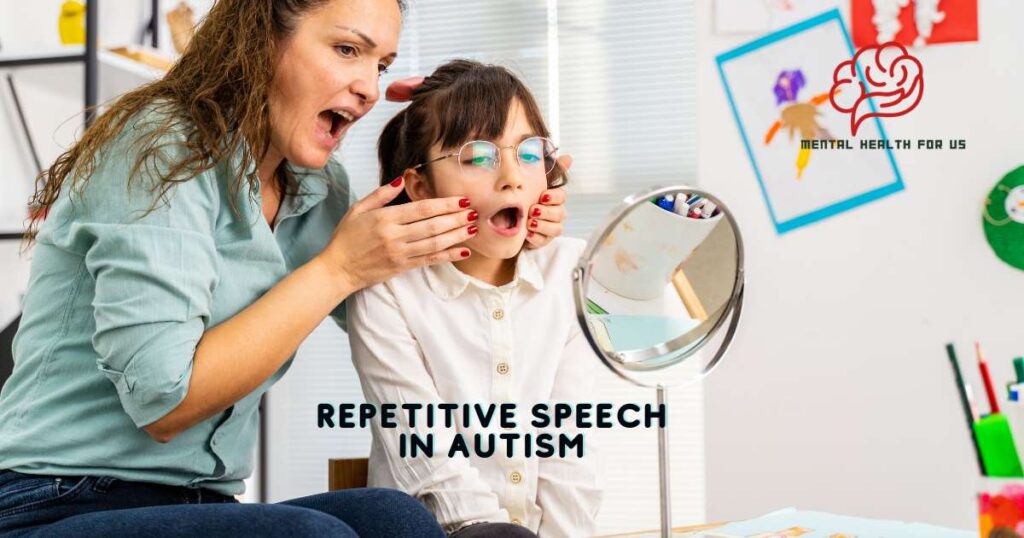What is Repetitive Speech (Echolalia)?
Individuals with Autism spectrum disorder (ASD) typically exhibit echolalia or repetitive speaking. Echolalia is repeating words or phrases uttered by others, either immediately or afterward. They might echo the exact words heard or delayed words or phrases heard in the past. Atypical language development includes echolalia in children with autism.Thus, Autistic individuals may improve their communication abilities by reducing and redirecting echolalia. In this blog, we will discuss tips and tricks for how to stop repetitive speech in autism.
How to stop repetitive speech in autism?
Here are some methods to stop repetitive speech in autism
- Provide Structure and Predictability: Autistic individuals thrive in organized environments with regular routines. Clear routines and visual supports lessen anxiety and predictability, minimizing the need for recurrent speech for comfort or control. Visual schedules, social stories, and timetables can assist people in grasping their day.
- Teach Communication Alternatives: Instead of using repetitive words, Autistic individuals can learn other ways to express their demands. This can include teaching them photo interchange, AAC, and sign language. By providing alternate communication methods, Autistic individuals may use less repetitive speech.
- Promote Functional Communication: Reward effective communication beyond repetitive speech. If a child is repeating a request, encourage them to say “I want the red ball.” Rewarding functional communication encourages Autistic individuals to utilize more flexible language and avoid repetitive speaking.
- Use Visual Supports for Language Expansion: Visual timetables, reminders, and cues can help expand language. Vision and speech can help Autistic individuals understand and use more diverse and flexible language. By increasing vocabulary and linguistic skills, people may speak less repetitively.
- Teach Autism with Social Narratives and Scripts: Social narratives and scripts help teach autism social communication and conversation abilities. These tools arrange social interactions and teach back-and-forth talks. Predetermined scripts allow Autistic individuals to practice conversations without repeating speaking.
- Address Anxiety and Sensory Overload: Autism can cause repetitive speech due to anxiety or sensory overload. Visual relaxation, deep breathing, and sensory pauses can help people regulate their emotions and reduce repetitive speech. Minimizing sensory triggers can also help create a sensory-friendly atmosphere.
- Get Professional Help: speaking-language pathologists and behavior therapists can help Autistic individuals and their families with repetitive speaking. These specialists may customize therapy, structure sessions, and track progress.
Remember, autistic individuals’ repetitive speech requires empathy and understanding. Each person has different communication talents and weaknesses. These tactics and collaboration with professionals and caregivers can help Autistic individuals improve their communication skills and quality of life.

Speech Therapy for Autism can help to stop repetitive speech in autism
Create a Positive Environment
A good environment can considerably impact the well-being and development of individuals with autism spectrum disorder (ASD). A caring, sympathetic, and nurturing environment can help Autistic individuals thrive in many ways. These methods can help autism-friendly environments:
- Acceptance and Understanding: Fostering acceptance and understanding is crucial to a positive atmosphere. Teach others about autism’s unique traits. This understanding will help you comprehend autism’s issues and give necessary assistance and accommodations.
- Clear and Consistent Communication: Autistic individuals thrive on clear and consistent communication. Use clear, explicit language, visual schedules, and social stories, and clarify instructions and expectations. This will reassure Autistic individuals and lessen anxiety.
- Structure and Routine: Autistic individuals benefit from routines. Create a timetable with regular activities and transitions and utilize visual supports to assist people in comprehending and anticipating daily happenings. autistic individuals can feel stable and less stressed with consistency and predictability.
- Positive Reinforcement: Positive reinforcement creates a positive environment. Celebrate even minor autism triumphs. Motivate positive behavior in autism using rewards, praise, and encouragement. Autistic individuals gain confidence and self-esteem.
- Sensory-Friendly Environment: Autism often causes sensory sensitivity. Sensory-friendly environments lessen sensory overload and make people more comfortable. Consider brightness, noise, and relaxing sensory stimuli like weighted blankets or fidget toys. Creating a relaxing environment can help Autistic individuals.
- Individualized Support: Each autistic person has distinct strengths, problems, and preferences. Individualized support is essential for a positive environment. Learn about each person’s needs, interests, and strengths and adapt your interventions. This tailored approach values and respects the individual.
- Collaboration and Inclusion: Positive environments require collaboration and inclusion. Include family, caregivers, and professionals in the individual’s support team and work toward goals. Encourage peer, family, and community inclusion and social interactions. This helps Autistic individuals learn social and communication skills and feel included.
Building a positive atmosphere for Autistic individuals takes patience, understanding, and persistence. These practices can help Autistic individuals thrive in a supportive setting. How to stop repetitive speech in autism? Are you interested? Practice the above techniques at home.
Characteristics of Repetitive Speech in Autism
In order to understand “how to stop repetitive speech in autism?” We need to have an idea about speech characteristics. Autism is a neurodevelopmental disorder that affects communication abilities and other areas of life. Communication issues in autistic children include echolalia or repetitive speech. Echolalia is the repeating of others or one’s own speech. It’s normal for some kids to acquire language, but autism may make it more noticeable.
Immediate and delayed echolalia are two types of repetitive speech. Repeating words or phrases heard from another person is immediate echolalia, whereas delayed echolalia is repeating phrases or utterances out of context words or phrases that have been heard before hours or even days. These repeating utterances may be uttered immediately or later and may be used to communicate, self-regulate, self-soothe, or analyze information.
Repetitive speech may help Autistic individuals retain regularity and familiarity. They feel safer with repetition’s order and comfort. Repetition of sentences into one’s own language may also be a kind of communication, according to some studies.
While repetitive speech can cause issues, it should be addressed when it becomes excessive or hampers communication and social engagement. Autistic individuals may lessen repetitive speech using these methods:
- Understanding the Function: Each person must determine the purpose of repetitive speech. Is it for self-soothing, communication, or information processing? By understanding function, relevant treatments may be created.
- Modeling and Expanding Language: Expressive language development reduces repetitive speech. Provide examples of acceptable and diverse language usage, vocabulary expansion, and sentence building.
- Visual Supports: Visual calendars, social narratives, and visual signals may assist Autistic individuals in following routines. Visual aids transmit information clearly and concisely, reducing the need for repetitive speech.
- Functional Communication Training: Learning new communication skills helps lessen repetitive speech. Use gestures, signs, augmentative and alternative communication methods, or assistive technology.
- Speech and Language Therapy: Autism-specialized speech-language pathologists may help. They may create tailored treatment programs to alleviate repetitive speech and improve communication.
- Positive Reinforcement: Encourage good communication and gently correct or ignore bad words. Positive reinforcement motivates and encourages flexible language.
- Working with Communication Partners: Informing family, teachers, and peers about repetitive speech in autism may help them understand and support it. Consistent methods between communication partners may reduce repetitive speech and improve meaningful conversations.
Repetitive speech is part of autism’s communication profile, yet it may be difficult. Empathy, tolerance, and understanding may help Autistic individuals communicate and socialize.
Causes of Repetitive Speech in Autism
Echolalia, or repetitive speech, is frequent in autism spectrum disorder. Understanding the reasons for repetitive speech is essential to managing it.
Biological Factors
While environmental and social variables may cause repetitive speech in autism, biological factors must be considered to understand and treat this behavior. Here, we examine biological mechanisms that affect repetitive speech in autism.
Autism is a neurodevelopmental condition with abnormal brain development and function. Research reveals that brain anatomical and functional variations may cause repetitive speech in autism. Changes in language and communication neural networks might make language processing and production challenging.
There is emerging evidence that autism is genetic. Mutations and changes in genes have been linked to autism spectrum disease. These genetic variables can affect brain development, language, and communication. Certain gene mutations are associated with repetitive behaviors, including speech, in ASD.
Sensory Processing: Autism often affects sensory processing. Sensory overload makes it hard to filter and comprehend auditory information. To deal with sensory overload, repetitive speech may occur. Focusing on repetitive speech may help Autistic individuals cope with sensory overload.
Executive functioning: Cognitive processes that help people plan, organize, and complete complicated tasks. Executive functioning deficiencies might affect autistic individuals’ ability to initiate and switch language or communication techniques. Speech repetition may result from difficulty developing alternate responses or changing language use to context or discussion.
Imbalance of neurotransmitters: Brain chemicals regulate several brain functions. Autism may cause repetitive speech due to serotonin and dopamine imbalances. These imbalances can affect language modulation and repetitive behavior inhibition.
Note that these biological elements interact with each other and with environmental and social factors to affect repetitive speech in autism. Understanding these neurological bases is essential for designing comprehensive autism communication interventions and methods.
Overall, neurological variations, genetics, sensory processing issues, executive functioning impairments, and neurotransmitter imbalances can cause repetitive speech in autism. These biological characteristics can help professionals build targeted interventions and support techniques to improve language flexibility and adaptability for Autistic individuals, improving communication and social relationships.
Environmental Factors
Environmental factors can cause repetitive speech in autism in addition to biological factors. The external forces a person with autism experiences daily can affect their communication abilities and conduct.
Social engagement and communication are essential environmental factors for Autistic individuals. Autism can cause repetitive speech due to social communication and interpersonal issues. Autism may cause a youngster to use repetitive speech to fill communication gaps or stay engaged.
The autistic child’s language skills and development also affect repetitive speaking. Chunks of language impairments or difficulties in certain children with autism might lead to a reliance on familiar words or scripts for social interactions. These repeating speaking patterns may compensate for social unpredictability and structure.
The communication partners of Autistic individuals also affect their repetitive speech. Communication partners who constantly respond to and support repetitive speech may unintentionally reinforce this habit, according to research. However, when communication partners supply more varied and flexible communicative functions, autistic children may develop more adaptive and flexible language skills.
Sensory environmental elements can also cause repetitive speech in autism. Autism often causes sensory processing issues that affect how people interact with the world. Hypersensitivity to sounds or settings may cause repetitive speech to self-regulate and cope with sensory overload.
Environmental factors are crucial to understanding and treating repetitive speech in autism. A friendly and enriching setting can help Autistic individuals improve their communication skills and reduce repetitive speech. This can include structured routines, social interaction, and flexible linguistic interventions.
To explain autism’s repetitive speech, biological and environmental factors must be examined. Addressing biological and environmental variables can help autism improve communication and quality of life.
The Effects of Repetitive Speech in Autism
Repetitive speech can aid self-soothe or communication but can potentially damage language and social development.
Repetitive speech in autism may inhibit expression. Kids with echolalia may utilize scripts or repetitive phrases instead of developing their own language. This makes it challenging to express thoughts, feelings, and connections.
Repeating words hampers social interaction. Autism-related repetitive speech can make conversation difficult and difficult to understand. Social partners may shun someone whose speech patterns limit reciprocal dialogue, causing dissatisfaction and loneliness.
Repetitive speaking might cause miscommunication. Those with autism may repeat words and phrases without understanding. This makes it hard to convey or understand others’ intentions, hindering social relationships and communication.
Stigma and social isolation can emerge from repetitive speech. Negative attitudes and marginalization may result from classmates and peers finding repetitive speech odd. Repetitive speech can draw attention, making it harder for autistic persons to make friends and feel accepted.
Autism individuals need help reducing repetitive speech for health and development. Communication therapy and speech-language pathology promote language flexibility and lessen repetitive speaking. Visual support, social storytelling, and realistic language teaching encourage spontaneous and varied conversation.
A supportive environment that promotes socializing and communication is essential. Encourage friends, teachers, and family to talk, and show patience and compassion to help Autistic individuals develop their communication skills.
Developmental Milestone Effect
Addressing repetitive speaking in autism requires considering developmental milestones. A child’s communication, social, and language skills develop through milestones.
Autism can delay important stages with repetitive speech. Repeating words and phrases may limit a child’s vocabulary and language skills. They may remember scripts or formulas instead of actively participating in conversations and learning from their environment, which may not be useful elsewhere. Language sensory input is normal. In some cases, there is only language delay. These problems can persists in adolescents with autism
Repeating speech hampers communication and social skills. Back-and-forth, turn-taking, and nonverbal cues are crucial to communication. However, repetitive speech can disrupt conversation and make it hard for autistic youngsters to interact. This may make it challenging to form and maintain meaningful relationships with peers, family, and friends.
Repetitive speech may impair development beyond linguistic and social skills. It hinders independent problem-solving and reasoning. Autism may inhibit children from developing critical thinking and imaginative problem-solving skills by using repetitive speech.
Repetitive speech can also stigmatize a child, hurting their self-esteem and mental health. Others may find their repetitive speech odd, causing social isolation. Negative events may hinder a child’s socio-emotional growth.
Reducing repetitive speech helps autistic children develop. Speech-language therapy promotes spontaneous language use and adaptability. Therapists and educators can help autistic children gain language and social skills using regulated monitoring, visual assistance, and naturalistic language instruction.
Also crucial is creating an inclusive, supportive environment. School, parents, and peers can assist autistic youngsters in improving their communication skills. Encourage patient and understanding interactions, establish discussions, and participate socially to help the child accomplish developmental goals and form meaningful relationships.
Affective and Social Interaction Issues
Touch and social interaction difficulties are common in autism spectrum disorder (ASD). Autism impacts how people view and absorb social information, making it challenging to build meaningful relationships and feel emotions. Toe walking is also common in this psychiatric disorder
Effective involvement requires expressing and acknowledging emotions. ASD individuals may have problems recognizing facial expressions, body language, and tone of voice, which are crucial to understanding emotions. This may cause miscommunication and difficulty reading others’ feelings.
Autistic persons may have trouble socializing. They may struggle to understand social norms, making interactions and connections challenging. This causes loneliness, isolation, and limited social networks.
A lack of shared attention is another autistic difficulty. Social interaction requires shared attention to understand and communicate. Children with Autism can make cooperative play, back-and-forth discussion, and group activities difficult.
Social relationships may be difficult for sensory-sensitive Autistic individuals. ASD sufferers are sensitive to loud noises and bright lights. These sensitivities can be overwhelming and distracting, making socializing and focusing on social cues difficult.
Autism’s affective touch and social interaction impairments require diverse treatment. People with Autism can develop communication and social skills through speech-language therapy and social skills training. These therapies can help individuals interpret social cues, express feelings, and navigate social situations.
Autistic individuals require a welcoming place to practice socializing in addition to therapy. Peers, family, and education encourage social involvement, understanding, and inclusion. A supportive network can assist autistic persons in making meaningful social ties and improving contact.
Remember that each autistic person has various social obstacles. To improve good behaviors in Autism requires patience, sensitivity, and adaptability. By recognizing and meeting their requirements, we can create a pleasant social environment for Autistic individuals.
Conclusion
Autism-related echolalia can be non-functional echolalia. It demands a complex and specific treatment. How to stop repetitive speech in autism? This requires understanding the reasons, positive reinforcement, functional communication teaching, and professional assistance may help autistic persons communicate better and eliminate repetitive speech patterns. Speech Therapy for one autistic person may not work for another. Interventions must conform to individual requirements and preferences. Echolalia in autistic persons requires patience, tenacity, and a team of specialists and caregivers.
FAQs
How to Avoid Autism Repetitive Behaviors?
To avoid repetitive behaviors, autism needs behavioral treatment, sensory regulation, social skills training, and communication assistance. Reducing and managing repetitive habits needs personalized treatments. A loving and supervised environment may help Autistic individuals flourish and decrease repetitive behaviors.
Types of Echolalia?
There are two primary echolalia types:
Immediate echolalia: Repeating words or phrases immediately after hearing them.
Delayed echolalia: Words, phrases, and sentences are repeated hours or weeks after first language exposure.
How long is echolalia normal?
Echolalia is common in children with autism spectrum disorder and preschool language development. Most children outgrow echolalic speech as they learn language. However, if echolalia remains beyond 3-4 years and seriously hinders communication, a healthcare practitioner or speech therapist should be consulted.







